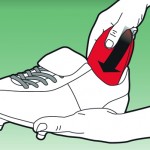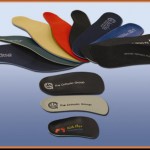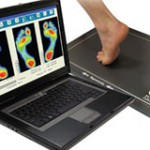How to choose the best football boots by Olivia O’ Leary D.C BSc Hons Chiropractic
Customise your Footwear to Stay out of the Treatment Room….
At some point in the season whether its pre season or mid way in, new football boots are a necessity. Finding the right boot is very important consideration for prevention of sports injury as well as comfort.
With a lot of young footballers that we see at Gorey Family Chiropractic experiencing conditions like Severs disease, shin splints, hamstring strains, as well as knee ligament problems we thought we would take a look at how to try to prevent these injuries and enhance performance through the right equipment, starting with how to choose and improve football boots.
 From a support point of view the upper needs to be strong enough to support your foot during rapid changes in direction and when kicking. Although generally more expensive, a leather upper will mould to the shape of your feet and is very durable meaning it will age well. The soft nature of leather means it is very comfortable.
From a support point of view the upper needs to be strong enough to support your foot during rapid changes in direction and when kicking. Although generally more expensive, a leather upper will mould to the shape of your feet and is very durable meaning it will age well. The soft nature of leather means it is very comfortable.
Synthetic uppers vary in quality at either end of the price scale. High quality synthetic upper is found on many modern football boots as it is strong, light and waterproof. However, some cheaper synthetic uppers may have a poor feel and will rip and tear easily under strain and tend to be found on boots at the lower end of the market. Combination leather and synthetic uppers are the strongest particularly when reinforced with ample stitching.
Heel Cup; Give Your Heels Height
 The heel counter or heel cup needs to be very rigid to support your rear foot during swerving & stepping. A sturdy deep heel cup can prevent injuries especially in young footballers.
The heel counter or heel cup needs to be very rigid to support your rear foot during swerving & stepping. A sturdy deep heel cup can prevent injuries especially in young footballers.
The idea of inserting in-shoe ‘lifts’ into your boots may sound like a ruse to give some added height to the front line, but podiatrists believe that raising the heel with orthopaedic supports (orthotics) can lower the risk of Sever’s disease among young players. Sever’s is an inflammation of the area where the Achilles tendon joins the heel – common in the growing joints of young adolescent players. In an FA survey these conditions were found to account for over 13 per cent of injuries to footballers aged 11-13.
Midsole
There are boots on the market that have midsoles or wedges under the heel providing some cushioning and support which is desirable for injury prevention. These are particularly good for young footballers that suffer from heel pain or any player that suffers from lower limb injuries such as shin splints, achilles tendonitis or chronic knee injury or pain. The extra bulk in this type of boot is the only downside.
Outsole
The outsole must be rigid and match the width of the foot. A narrow outsole will cause the foot to hang over the edge of the sole and place more pressure on the upper, which decreases the stability of the boot and is more likely to tear the boot.
Moulded Vs Screw-In Studs
The type of pitches that you will be playing on make a significant difference to the type of boot that you  should consider buying. Soft ground conditions require better grip so use of screw-in studs is suitable for use on soft, wet and muddy pitches. The studs are usually made from hard rubber although metal studs are available.
should consider buying. Soft ground conditions require better grip so use of screw-in studs is suitable for use on soft, wet and muddy pitches. The studs are usually made from hard rubber although metal studs are available.
Anyone who has had a knee reconstruction or suffers from instability in the knee joint should be careful not to use an aggressive stud design as the increased grip may cause the foot to remain stuck in the turf potentially leading to excessive twisting and injury. Use of screw-in studs on hard grounds is not comfortable as a footballer or hurler can feel like they are running on pebbles.
Moulded stud boots are better suited to harder grounds. They are designed for surfaces where there is limited give. Moulded boots are also usually used on artificial and synthetic pitches as they tend to not get stuck in the turf like studs do reducing the likelihood of twisting knee injuries.
 The ideal situation for the serious player is to own a pair of boots for every condition. However, in this recessionary environment that approach can be pricey so the general player should buy a single pair of boots that that will suit the surface he or she most often plays on. With Wexford gaelic, hurling, soccer & rugby generally played in soft conditions at this time of year, boots with screw in studs are most appropriate.
The ideal situation for the serious player is to own a pair of boots for every condition. However, in this recessionary environment that approach can be pricey so the general player should buy a single pair of boots that that will suit the surface he or she most often plays on. With Wexford gaelic, hurling, soccer & rugby generally played in soft conditions at this time of year, boots with screw in studs are most appropriate.
Fit
A correctly fitted boot is an important factor in prevention and treatment of foot injuries. There should always be a thumb nail width from the longest toe to the end of the boot. There should also be adequate depth to ensure your foot sits securely in the boot.
Badly fitting boots are a recipe for poor performance and injury. A boot that is too big will allow the foot to move within it, ruining any chance of fine ball control, quick acceleration or manoeuvrability. A boot that is too small will be uncomfortable to play in and may result in foot damage.
Orthotics
Football boots do accept specially moulded sports orthotics / insoles. Custom Made Sports Orthotics / insoles help correct abnormalities in the way an individual moves, for example if you foot turns inward when you run or if you suffer from fallen arches. These types of orthotics are designed to prevent sports related injuries and help protect against pressure and impact shock. Depending on which sport you participate in, sports specific orthotics will be prescribed to meet the needs of different sports from soccer to golf to tennis and running.
We offer state of the art TOG Gait Scan technology at Gorey Family Chiropractic which allows a computerised can of a foot to be taken and from this information a custom made insole is created which works both correctively and preventatively. This technology therefore looks beyond just treating symptoms but determines the root cause of the problem and addresses the malfunction of the foot that has led to the foot pain or problems. These sports orthotics can  be placed into your football boots to offer an increased level of support and with the goal of injury prevention and enhanced performance. The Tog orthotics supplied by Gorey Family Chiropractic come with a lifetime guarantee against cracking of the supportive shell ensuring support for the long term for your feet.
be placed into your football boots to offer an increased level of support and with the goal of injury prevention and enhanced performance. The Tog orthotics supplied by Gorey Family Chiropractic come with a lifetime guarantee against cracking of the supportive shell ensuring support for the long term for your feet.
Gorey Family Chiropractic Supporting your Recovery and Enhancing your Performance
For further information on Tog Orthotics/ insoles please see the Tog Orthotics video on the practice videos section on our website http://www.chiropractor.ie/5,gallery,orthotics_patient_education_dvd.html. Alternatively contact the practice to arrange a personal computerised assessment with one of our clinical team.
If you are troubled by any of the sports injuries mentioned above please feel free to contact our practice to arrange an assessment. For your convenience all of our clinical team are registered with VHI, Aviva, Glo and Laya Healthcare allowing clients claim reimbursement from a wide range of private healthcare Insurance providers.We also provide care under the GAA injury scheme.
Opening hours Mon 8-7, Tues 9-5, Wed 8-7, Thurs 9-5, Frid 8-7
T : 053 94 83338 or alternatively email info@chiropractor.ie.
Gorey Family Chiropractic Clinic, Railway Road, Gorey, Co Wexford.
















